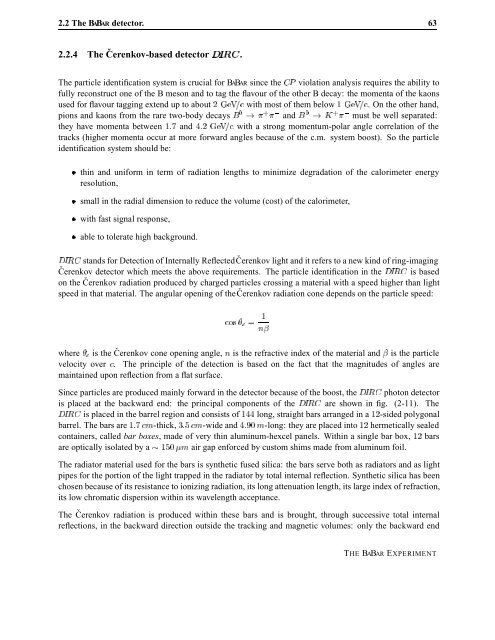Violation in Mixing
Violation in Mixing
Violation in Mixing
Create successful ePaper yourself
Turn your PDF publications into a flip-book with our unique Google optimized e-Paper software.
2.2 The BABAR detector. 63<br />
2.2.4 The Čerenkov-based detector �ÁÊ�.<br />
The particle identification system is crucial for BABAR s<strong>in</strong>ce the �È violation analysis requires the ability to<br />
fully reconstruct one of the B meson and to tag the flavour of the other B decay: the momenta of the kaons<br />
used for flavour tagg<strong>in</strong>g extend up to about ��� with most of them below ���. On the other hand,<br />
pions and kaons from the rare two-body decays � � � � and � � Ã � must be well separated:<br />
they have momenta between �� and �� ��� with a strong momentum-polar angle correlation of the<br />
tracks (higher momenta occur at more forward angles because of the c.m. system boost). So the particle<br />
identification system should be:<br />
¯ th<strong>in</strong> and uniform <strong>in</strong> term of radiation lengths to m<strong>in</strong>imize degradation of the calorimeter energy<br />
resolution,<br />
¯ small <strong>in</strong> the radial dimension to reduce the volume (cost) of the calorimeter,<br />
¯ with fast signal response,<br />
¯ able to tolerate high background.<br />
�ÁÊ� stands for Detection of Internally ReflectedČerenkov light and it refers to a new k<strong>in</strong>d of r<strong>in</strong>g-imag<strong>in</strong>g<br />
Čerenkov detector which meets the above requirements. The particle identification <strong>in</strong> the �ÁÊ� is based<br />
on the Čerenkov radiation produced by charged particles cross<strong>in</strong>g a material with a speed higher than light<br />
speed <strong>in</strong> that material. The angular open<strong>in</strong>g of theČerenkov radiation cone depends on the particle speed:<br />
Ó× � � Ò¬<br />
where � is the Čerenkov cone open<strong>in</strong>g angle, Ò is the refractive <strong>in</strong>dex of the material and ¬ is the particle<br />
velocity over . The pr<strong>in</strong>ciple of the detection is based on the fact that the magnitudes of angles are<br />
ma<strong>in</strong>ta<strong>in</strong>ed upon reflection from a flat surface.<br />
S<strong>in</strong>ce particles are produced ma<strong>in</strong>ly forward <strong>in</strong> the detector because of the boost, the �ÁÊ� photon detector<br />
is placed at the backward end: the pr<strong>in</strong>cipal components of the �ÁÊ� are shown <strong>in</strong> fig. (2-11). The<br />
�ÁÊ� is placed <strong>in</strong> the barrel region and consists of �� long, straight bars arranged <strong>in</strong> a -sided polygonal<br />
barrel. The bars are �� Ñ-thick, �� Ñ-wide and ��� Ñ-long: they are placed <strong>in</strong>to hermetically sealed<br />
conta<strong>in</strong>ers, called bar boxes, made of very th<strong>in</strong> alum<strong>in</strong>um-hexcel panels. With<strong>in</strong> a s<strong>in</strong>gle bar box, bars<br />
are optically isolated by a � � �Ñ air gap enforced by custom shims made from alum<strong>in</strong>um foil.<br />
The radiator material used for the bars is synthetic fused silica: the bars serve both as radiators and as light<br />
pipes for the portion of the light trapped <strong>in</strong> the radiator by total <strong>in</strong>ternal reflection. Synthetic silica has been<br />
chosen because of its resistance to ioniz<strong>in</strong>g radiation, its long attenuation length, its large <strong>in</strong>dex of refraction,<br />
its low chromatic dispersion with<strong>in</strong> its wavelength acceptance.<br />
The Čerenkov radiation is produced with<strong>in</strong> these bars and is brought, through successive total <strong>in</strong>ternal<br />
reflections, <strong>in</strong> the backward direction outside the track<strong>in</strong>g and magnetic volumes: only the backward end<br />
THE BABAR EXPERIMENT















